How to Fall Back Asleep After Waking Up
😴 Introduction: When Sleep Feels Fragile
You roll over in the dark and glance at the clock.
2:57 a.m.
You tell yourself not to look — but it’s too late.
Your mind’s awake, your body’s tense, and the silence feels loud.
Nighttime awakenings are one of the most common sleep struggles for adults. Even if you fall asleep easily, staying asleep can be another story — especially during stressful periods or hormonal changes.
But here’s the good news: you can train your body and brain to fall back asleep quickly and gently.
This article explores:
The main causes of middle-of-the-night awakenings
Simple, evidence-based techniques to calm your body
Natural supplements that help restore sleep continuity
What to do and not do during those restless moments
Let’s reclaim your deep rest — even after 3 a.m. wakeups. 🌙
Looking for supplements for This? Click here.
🧠 Part 1: Why You Wake Up in the Middle of the Night
Before fixing the problem, it helps to understand what’s happening.
Your sleep isn’t a single, continuous block. It cycles through stages (N1, N2, N3, and REM) roughly every 90 minutes. Between each cycle, you briefly awaken — most people just don’t notice.
When these transitions become too alert, your brain “snaps on,” leading to full awakenings.
Here are the most common reasons that happens:
⚡ 1️⃣ Cortisol Spikes
Cortisol, your stress hormone, should be low at night and rise toward morning.
But chronic stress, anxiety, or overtraining can trigger premature spikes, waking you up wired.
You might notice:
Racing thoughts
Warm body temperature
Restlessness or anxiety
💧 2️⃣ Blood Sugar Drops
If your last meal was too light or carb-heavy, your blood glucose can fall during the night.
When that happens, your body releases adrenaline to mobilize energy — and you wake up suddenly.
Common signs:
Waking around 2–3 a.m.
Slight heart racing
Hunger or irritability
🔋 3️⃣ Overstimulation Before Bed
Late-night screen time, caffeine, or intense mental work delay melatonin release and keep your nervous system alert.
That means even if you fall asleep, your brain may rebound into wakefulness later.
🌡️ 4️⃣ Temperature Fluctuations
Your body needs to cool down to stay asleep.
A hot room, heavy blankets, or hormonal changes can cause overheating and awakenings.
🧘 5️⃣ Emotional Processing
Your brain consolidates memories and emotions during REM sleep.
If you’re under stress or unresolved tension, your mind may literally “wake up to process it.”
Understanding the root cause helps you choose the right technique — whether it’s nutrition, breathwork, or stress management.
🌬️ Part 2: The First 60 Seconds — Don’t Panic

The moment you realize you’re awake, the key is to stay calm.
Your mindset determines whether your body drifts back into sleep or spirals into alertness.
🕯️ Step 1: Stay Still
Avoid tossing, turning, or checking your phone.
Movement increases heart rate and signals the brain that it’s time to wake.
🌙 Step 2: Keep Your Eyes Closed
Light exposure suppresses melatonin and wakes the visual cortex.
Even a glance at your alarm clock can restart your circadian countdown.
🌬️ Step 3: Breathe — Don’t Think
Shift your focus from thoughts to breath.
Try this:
Inhale 4 seconds → Hold 2 → Exhale 6–8 seconds.
This activates the parasympathetic nervous system, calming your heart rate.
💡 Remember: you don’t have to fall asleep — just relax. Sleep will follow naturally.
🌿 Part 3: Breathing and Body Techniques That Work
When you can’t sleep, your body needs to feel safe before your mind can let go.
Here are proven techniques to lower nighttime arousal.
🫀 1️⃣ The 4-7-8 Method
Developed by Dr. Andrew Weil, this breath pattern mimics the body’s natural relaxation rhythm.
Inhale through your nose for 4 seconds
Hold for 7 seconds
Exhale through your mouth for 8 seconds
Repeat 4–6 times.
It slows the heartbeat, lowers blood pressure, and quiets mental chatter.
🌊 2️⃣ Wave Breathing
Visualize your breath as a gentle tide.
Inhale as the wave rises, exhale as it falls.
This rhythmic imagery triggers alpha brain waves, associated with calm and pre-sleep relaxation.
🧘 3️⃣ Progressive Muscle Relaxation
Starting from your toes, gently tense and release each muscle group.
This releases physical micro-tension and diverts attention away from racing thoughts.
🧠 4️⃣ Label the Thought, Then Let It Drift
If you find yourself overthinking, try naming it:
“Planning.”
“Remembering.”
“Worrying.”
Then visualize placing that thought on a cloud and letting it float away.
You don’t fight thoughts — you observe and release.
Want to try Breathwork? Click Here.
🩵 Part 4: What to Avoid When You Wake Up
Some habits keep you stuck awake. Here’s what to skip:
📱 1️⃣ Don’t Look at Your Phone
Even a quick peek floods your eyes with blue light, suppressing melatonin and spiking dopamine.
This tells your brain: “Morning’s here!”
⏰ 2️⃣ Don’t Check the Clock
Clock-watching builds anxiety (“Oh no, it’s 3 a.m. — only four hours left!”).
That cognitive stress keeps your cortisol high.
💭 3️⃣ Don’t Try Too Hard
Effort creates tension.
Instead of forcing sleep, focus on relaxation as the goal. Sleep will emerge naturally.
☕ 4️⃣ Don’t Consume Alcohol or Sugar Before Bed
Both may make you sleepy initially but lead to rebound awakenings once metabolized.
🌙 Part 5: The Role of Supplements in Falling Back Asleep
Certain nutrients can stabilize nighttime physiology, making it easier to drift back off when you wake.
Here are the most research-backed options:
🧂 1️⃣ Magnesium Glycinate — The Nervous System Soother
Magnesium supports GABA activity, reduces cortisol, and relaxes muscles.
How it helps:
Calms the nervous system
Prevents muscle cramps and restless legs
Regulates nighttime cortisol spikes
Dosage: 200–400 mg glycinate or threonate before bed.
🍵 2️⃣ L-Theanine — Quieting Mental Noise
Found in green tea, L-theanine promotes alpha brain waves and relaxation without drowsiness.
How it helps:
Reduces anxiety-related awakenings
Improves sleep quality when combined with magnesium or glycine
Dosage: 200–400 mg.
🧘 3️⃣ Glycine — The Body’s Cool-Down Amino Acid
Glycine lowers core body temperature, helping the body re-enter sleep faster.
Benefits:
Increases deep sleep time
Reduces next-day grogginess
Dosage: 3 g before bed or upon waking at night.
🌾 4️⃣ GABA — The Mind’s Brake Pedal
Supplemental PharmaGABA® mimics your brain’s natural inhibitory neurotransmitter.
Benefits:
Slows racing thoughts
Promotes smooth sleep transitions
Dosage: 100–200 mg before bed or mid-night.
🍒 5️⃣ Tart Cherry Extract — Natural Melatonin Boost
Tart cherries contain melatonin and tryptophan precursors.
Benefits:
Supports melatonin rhythm
Aids recovery and reduces inflammation
Dosage: 480 mg extract or 8 oz juice before bed.
🌿 6️⃣ Ashwagandha — The Cortisol Balancer
An adaptogen that moderates your stress response and stabilizes nighttime hormones.
Dosage: 300–600 mg standardized extract.
⚡ 7️⃣ Omega-3s — Supporting Serotonin and Calm
Omega-3s help regulate melatonin synthesis and reduce inflammation linked to poor sleep continuity.
Dosage: 1000–2000 mg EPA + DHA daily.
Looking for supplements for This? Click here.
🧘 Part 6: Calming Rituals for 2 a.m. Wakeups
If you’re awake for more than 10–15 minutes, it can help to reset gently instead of lying frustrated.
🕯️ 1️⃣ Get Out of Bed Slowly
Stay in dim light and do something calming, like:
Reading a few pages of a gentle book
Sitting quietly and focusing on breath
Journaling a few thoughts to release mental load
Return to bed when your eyelids feel heavy again.
🌺 2️⃣ Aromatherapy
Scents like lavender, sandalwood, or chamomile activate parasympathetic calm and lower heart rate.
Try:
Diffusing essential oils
Spraying a lavender mist on your pillow
📖 3️⃣ Mental “Counting Clouds”
Instead of counting sheep, visualize drifting clouds or waves.
This rhythmic mental imagery keeps your brain occupied without overthinking.
🎧 4️⃣ White Noise or Slow Music
Gentle background sound masks small disturbances and provides a consistent sensory cue for sleep.
🍽️ Part 7: Nutritional Habits That Prevent Nighttime Wakeups
Your daily nutrition directly influences how stable your sleep remains overnight.
🥣 1️⃣ Eat a Balanced Evening Meal
Include protein, fiber, and healthy fats to maintain stable blood sugar through the night.
Example:
Salmon (protein + Omega-3s)
Quinoa (slow carbs)
Steamed greens + olive oil (fiber + magnesium)
🍌 2️⃣ Bedtime Snack (Optional)
If you tend to wake up hungry, try a light snack:
Banana with nut butter
Greek yogurt with berries
Whole-grain toast with almond butter
This prevents the 2 a.m. hypoglycemia spike that can trigger awakenings.
🚱 3️⃣ Hydrate — But Time It Right
Dehydration increases cortisol, but drinking too late leads to bathroom trips.
Drink steadily through the day, taper off an hour before bed.
🛏️ Part 8: Setting Up Your Environment
Your sleep environment should whisper “rest.”
🌡️ 1️⃣ Keep It Cool
Ideal sleep temperature: 18–20°C (65–68°F).
Use breathable sheets (cotton or bamboo) and avoid overheating.
💡 2️⃣ Block Out Light
Use blackout curtains or an eye mask. Even small light leaks suppress melatonin.
🔇 3️⃣ Reduce Noise
Use a fan, noise machine, or earplugs to mask disruptive sounds.
🧘 4️⃣ Keep Devices Out of Reach
Charge your phone outside the bedroom. This removes temptation and reduces EMF exposure.
🩵 Part 9: When Anxiety Keeps You Awake

Sometimes, the problem isn’t physical — it’s mental overactivity.
Your brain gets stuck in a loop of “What if I can’t sleep?” — a self-fulfilling cycle.
Here’s how to break it:
💭 1️⃣ Accept, Don’t Resist
The harder you try to force sleep, the more adrenaline you produce.
Instead, think: “It’s okay to rest. My body knows what to do.”
✍️ 2️⃣ Brain Dump
Keep a notebook nearby. Write down whatever’s looping in your head, then close it.
This signals closure — your brain can relax.
🧘 3️⃣ Try Mindful Repetition
Repeat a soothing word or phrase, such as “peace” or “I am safe.”
This anchors the mind and quiets intrusive thoughts.
🕰️ Part 10: Long-Term Strategies to Improve Sleep Continuity
To reduce future awakenings, strengthen your circadian rhythm.
🌞 1️⃣ Morning Sunlight
Expose yourself to natural light within 30 minutes of waking.
This resets melatonin timing and keeps your sleep drive strong.
🕒 2️⃣ Consistent Schedule
Go to bed and wake up at the same time daily — even weekends.
This trains your body clock to predict rest and wakefulness.
💪 3️⃣ Move Daily
Regular exercise improves deep sleep — just avoid intense sessions within 2 hours of bedtime.
☕ 4️⃣ Cut Caffeine Early
Caffeine’s half-life is 5–6 hours, meaning your afternoon cup lingers well into the night.
Stop by 2 p.m. for optimal sleep.
🧘 5️⃣ Practice Evening Wind-Down
Create a nightly ritual your brain associates with calm — stretching, dim lights, herbal tea, slow music.
🌈 Part 11: When to Seek Help
Occasional awakenings are normal.
But if you wake multiple times nightly for weeks despite healthy habits, consult a healthcare professional.
Possible underlying issues include:
Sleep apnea
Thyroid imbalance
Restless leg syndrome
Perimenopause or hormonal changes
Chronic stress or depression
Cognitive Behavioral Therapy for Insomnia (CBT-I) remains one of the most effective long-term solutions.
🌙 Final Thoughts: Learning to Trust Sleep Again
Falling back asleep isn’t about controlling your body — it’s about creating the conditions for surrender.
By combining the right mindset, breathing, nutrition, and natural support, you teach your nervous system to trust rest again.
Remember:
Don’t chase sleep — let it return.
Don’t fear wakefulness — it’s temporary.
Don’t give up — your body is wired for restoration.
You’re not broken.
You’re just learning how to find calm in the dark. 🌌
Looking for online therapy ? Click Here.
📚 References
Walker, M. Why We Sleep. Scribner, 2017.
Peuhkuri, K. et al. “Diet and Sleep: Nutrients and Sleep Regulation.” Nutrients, 2012.
Wienecke, E. et al. “Magnesium Supplementation and Sleep Quality.” J. Res. Med. Sci., 2016.
Bannai, M. et al. “Administration of Glycine Improves Sleep Quality.” Sleep and Biological Rhythms, 2012.
Kimura, K. et al. “L-Theanine and Stress Reduction.” Biological Psychology, 2007.
Langade, D. et al. “Ashwagandha Root Extract and Sleep Quality.” Cureus, 2020.
NCCIH. “Relaxation Techniques and Sleep Health.” NIH, 2023.
Huberman, A. “Tools for Falling Back Asleep.” Huberman Lab Podcast, 2023.
Chida, Y., Steptoe, A. “Cortisol Awakening Response and Stress.” Psychoneuroendocrinology, 2009.
Sarris, J. et al. “Herbal and Nutritional Sleep Aids.” Phytotherapy Research, 2020.
Related Posts
-

The Connection Between Creativity and Resilience
Creativity and resilience share the same roots — adaptability, flexibility, and imagination. Learn how creative expression rewires your brain for strength, helping you transform stress into growth through neuroscience, art, and self-reflection. 🌿
-

Why Cycling Supplements May Improve Long-Term Resilience
Your body adapts to everything — even supplements. Discover why cycling your supplements helps prevent tolerance, boost energy naturally, and build lasting resilience by aligning with your body’s biological rhythms. 🌿
-

The Role of Biofeedback in Emotional Strength
Learn how biofeedback bridges mind and body — helping you monitor heart rate, breath, and brain activity to build emotional strength, resilience, and calm under pressure. See how science meets mindfulness for lasting control. 🌿
-

How to Stay Strong During Long-Term Stress
Long-term stress doesn’t just drain your energy — it rewires your biology. Discover science-backed ways to strengthen your body, balance your mind, and build lasting resilience through breathwork, nutrition, mindset shifts, and supplements that restore calm and focus. 💪
-

Resilience Training for Entrepreneurs
Entrepreneurship isn’t just about strategy — it’s about stamina. Discover how resilience training helps founders stay calm, clear-headed, and adaptable under pressure through neuroscience-backed habits, emotional regulation, and smart supplementation. 🌿
-

How Nootropics Can Boost Emotional Control
Emotions don’t have to control you. Discover how nootropics like L-theanine, ashwagandha, saffron, and omega-3s help balance brain chemistry, improve focus, and strengthen your ability to stay calm and composed under stress. 🌿
-

Stacking Adaptogens for Maximum Resilience
Adaptogens are nature’s stress shield — helping you stay calm, energized, and clear even under pressure. Learn how to stack herbs like ashwagandha, rhodiola, reishi, and schisandra for maximum resilience, balance, and long-term vitality. 🌿
-
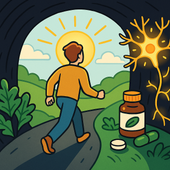
Post-Traumatic Growth and Supplements That Support It
After trauma, true healing means more than survival — it’s transformation. Learn how post-traumatic growth happens in the brain and body, and explore natural supplements like magnesium, ashwagandha, saffron, and omega-3s that support resilience, clarity, and emotional repair.
-
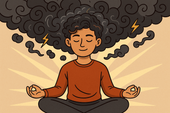
How to Regain Focus After Emotional Stress
After emotional stress, your nervous system feels frayed — your focus fades, thoughts race, and calm seems impossible. Learn how to restore balance, rebuild concentration, and retrain your brain for clarity and peace through evidence-based mind–body tools. 🌿
-
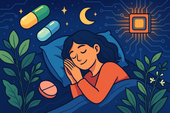
The Future of Sleep Supplements
The future of sleep supplements is here — where science meets nature. Discover how next-generation formulas use adaptogens, amino acids, and biotech innovations to support deep, restorative sleep without dependency. 🌙
-
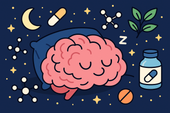
Emerging Research on Sleep and Nootropics
Can nootropics help you sleep better? Discover how compounds like L-theanine, magnesium threonate, ashwagandha, and Alpha-GPC influence neurotransmitters, circadian rhythm, and brain recovery — bridging the gap between smarter days and deeper nights. 🌙
-

New Herbal Extracts for Deep Sleep
Discover the next generation of herbal extracts for deep sleep — from saffron and magnolia to jujube and lemon balm. Learn how these plant-based compounds calm the nervous system, balance cortisol, and promote truly restorative rest. 🌙
-
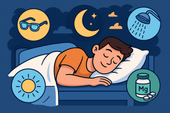
Sleep Biohacking: What Works and What Doesn’t
Biohacking your sleep can sound futuristic — from red light therapy to wearables and supplement stacks. But which hacks actually help, and which are just hype? Discover the science-backed sleep strategies that truly improve rest, recovery, and brain health. 🌙
-
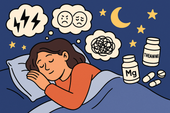
Sleep Support for People with Anxiety Disorders
💭 A restless mind can keep you up all night — thoughts spinning, heart racing, and peace feeling far away. Learn how to quiet overthinking, regulate your nervous system, and create a nightly ritual that teaches your brain to let go and rest deeply. 🌙
-
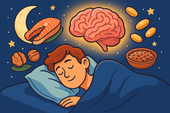
The Role of Omega-3s in Sleep Quality
-
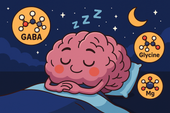
Stacking GABA and Glycine for Deeper Rest
Discover how stacking GABA and glycine can help you achieve deeper, more restorative sleep. Learn how these calming amino acids work together to relax your mind, soothe your body, and improve overall sleep quality—naturally and safely.
-

Overcoming Jet Lag with Supplements
✈️ Jet lag doesn’t have to ruin your trip! Discover how supplements like melatonin, magnesium, L-theanine, and tart cherry can help you reset your body clock faster, reduce fatigue, and recover energy naturally after long flights. 🌙
-
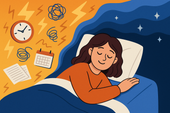
Managing Sleep During Times of Stress
Feeling wired and restless? Learn how to manage sleep during stressful times through nutrition, breathwork, and natural supplements like magnesium and L-theanine. Discover how to calm your nervous system and restore deep, peaceful rest—even when life feels overwhelming.
-
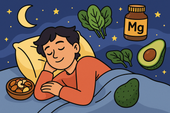
The Role of Magnesium for Night Cramps
Night cramps keeping you awake? Discover how magnesium helps relax muscles, balance electrolytes, and prevent painful spasms. Learn which forms work best, how to take them, and how to pair them with other nutrients for cramp-free, peaceful sleep.
-
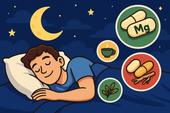
Supplements That Reduce Nighttime Awakenings
🌙 Discover science-backed supplements that help you stay asleep through the night. From magnesium and L-theanine to glycine and ashwagandha, learn how these natural compounds calm your nervous system, balance cortisol, and prevent 2 a.m. wake-ups for deeper, more restorative rest.
-
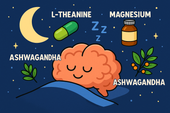
Nootropics That Promote Calm and Rest
Explore the world of calming nootropics — natural brain enhancers that promote relaxation, better focus, and deeper rest. Learn how L-Theanine, magnesium, ashwagandha, and other adaptogens help balance your nervous system, reduce stress, and support restorative sleep.
-
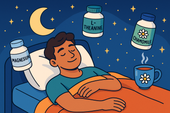
Best Natural Supplement Stack for Sleep
Discover the best natural supplement stack for deep, restorative sleep. Learn how nutrients like magnesium, L-theanine, glycine, and calming herbs such as chamomile and ashwagandha work together to relax your body, calm your mind, and improve sleep quality—naturally and safely.
-
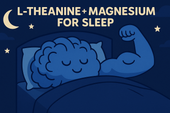
Combining L-Theanine and Magnesium for Sleep: A Calm Night, Naturally
Discover how combining L-Theanine and Magnesium can help you drift into deep, restorative sleep. Learn how this natural duo calms the mind, relaxes the body, and supports your nervous system—without grogginess the next morning.
-
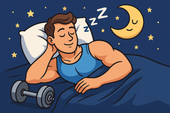
How to Sleep Better After Intense Workouts
Struggling to fall asleep after a tough workout? Learn how to optimize your post-training recovery with nutrition, hydration, and science-backed sleep strategies. Discover how to calm your nervous system, balance hormones, and wake up fully recharged for your next session.
-
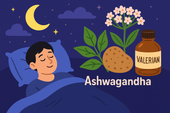
Ashwagandha and Valerian: A Bedtime Combo for Deep Rest and Emotional Reset
Discover the calming synergy of Ashwagandha and Valerian root, two natural sleep aids that help quiet the mind, ease anxiety, and promote deeper rest. Learn how this herbal duo supports the nervous system, balances stress hormones, and restores emotional peace — without next-day grogginess.
-

How to Create a Resilience-Boosting Diet
Discover how to build emotional and physical strength from the inside out with a resilience-boosting diet 🍎. Learn which foods stabilize your mood, how supplements like magnesium and omega-3s strengthen your stress response, and why pairing nutrition with breathwork and therapy creates lasting calm, focus, and vitality 🌿💪.
-

Best Teas and Herbal Blends for Calmness: Nature’s Way to Restore Inner Peace
Ashwagandha, the ancient adaptogenic herb, helps your body find balance during stress. Known as “Indian ginseng,” it supports cortisol regulation, boosts energy, and restores calm clarity. Discover how this powerful root promotes resilience, emotional balance, and steady vitality — one cup at a time. 🌸
-

Parenting and Emotional Strength: How to Raise Children Without Losing Yourself
Empathy is the bridge that connects hearts — the quiet power to understand, feel, and support another’s emotions without judgment. Learn how empathy strengthens relationships, enhances communication, and cultivates deeper compassion in everyday life. 🌿
-
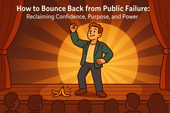
How to Bounce Back from Public Failure: Reclaiming Confidence, Purpose, and Power
Visualization is more than imagination — it’s brain training for resilience. By picturing calm, success, or healing, you activate the same neural pathways as real experience. Learn how daily visualization rewires your brain for confidence, emotional balance, and recovery from stress. ✨
-

Coping with Financial Stress Through Resilience: How to Stay Grounded When Money Feels Tight
Body awareness is the foundation of emotional resilience. By tuning into your body’s signals — tension, fatigue, or calm — you learn to recognize stress before it overwhelms you. Discover how mindfulness, gentle movement, and breathwork can deepen your connection with your body and restore balance from the inside out. 🧘
-

How to Stay Positive During Chronic Illness: A Guide to Emotional Strength and Hope
Creativity is more than art — it’s a form of healing. Whether through painting, writing, music, or small acts of expression, creativity helps release emotion, calm the nervous system, and reconnect you to joy. Discover how to use creativity as a tool for emotional balance, resilience, and self-discovery. 🌿
-
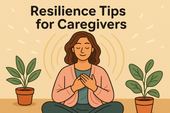
Resilience Tips for Caregivers: How to Stay Strong While Caring for Others
Joy isn’t the absence of pain — it’s the quiet strength to find light even in challenging times. Cultivating joy through small daily moments restores balance, releases stress, and reminds you of life’s beauty. Learn how to reconnect with authentic happiness, rebuild emotional energy, and nurture your nervous system through gratitude, presence, and play. 🌿
-

Building Resilience After a Breakup: How to Heal, Rebuild, and Rise Stronger
Social connection is one of the strongest predictors of emotional resilience. During difficult times, genuine relationships act as anchors — calming the nervous system, reducing stress hormones, and helping you regain perspective. Learn how cultivating real human connection can strengthen your mind, heart, and overall well-being. 🌿
-
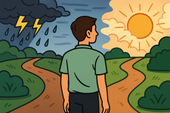
How to Stay Emotionally Strong During Job Loss
Your emotions are powered by brain chemistry — a delicate balance of neurotransmitters like serotonin, dopamine, and cortisol. When these chemicals work in harmony, you feel calm, focused, and resilient. Learn how daily habits, nutrition, and mindfulness can support your brain chemistry and boost emotional well-being naturally. 🌿
-
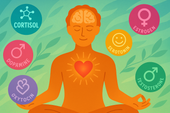
The Role of Hormones in Emotional Stability: How Your Chemistry Shapes Your Calm
Hormones shape more than your body — they shape your emotions, resilience, and sense of calm. From cortisol to serotonin, these chemical messengers influence how you react to stress, connect with others, and recover from challenges. Learn how to balance your hormones naturally to build lasting emotional stability and harmony within. 💫
-
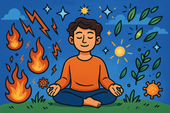
Mitochondria and Emotional Energy: The Cellular Power Behind Your Mood
Breathwork is one of the most powerful tools for emotional regulation and cellular balance. Through intentional breathing, you can calm your nervous system, increase oxygen flow to the brain, and even support mitochondrial energy. Learn how conscious breathing connects body and mind — transforming stress into presence and emotional strength. 🌿
-
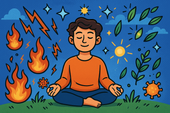
Inflammation and Its Impact on Mood Resilience: The Silent Link Between Body and Mind
Inflammation doesn’t just affect the body — it impacts the mind. Chronic inflammation alters brain chemistry, depletes serotonin, and makes emotional recovery harder. Learn how calming inflammation through nutrition, mindfulness, and sleep can restore balance, resilience, and a renewed sense of emotional strength. 💫
-
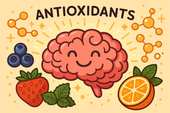
How Antioxidants Protect Emotional Well-being: The Hidden Link Between Oxidative Stress and Mental Health
Antioxidants do more than protect your body — they defend your mind. By neutralizing oxidative stress, antioxidants support serotonin, dopamine, and brain energy pathways that keep you calm, focused, and emotionally balanced. Discover how foods like berries, green tea, and dark chocolate nourish your brain, boost mood, and strengthen resilience from the inside out. 🌿✨
-
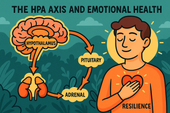
The HPA Axis and Emotional Health: The Hidden Bridge Between Stress and Mind
Neuroplasticity — the brain’s ability to rewire and adapt — is the foundation of emotional healing and resilience. When you face stress, trauma, or change, your neural pathways can reshape themselves to support new patterns of calm, focus, and self-awareness. Learn how daily practices like mindfulness, therapy, and breathwork strengthen neuroplasticity to transform emotional pain into personal growth. 🌸
-
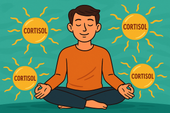
Why Cortisol Control Is Key to Resilience: Mastering Stress to Build Emotional Strength
Controlling cortisol — the body’s main stress hormone — is the secret to lasting resilience. When cortisol levels stay balanced, your mind becomes clearer, emotions steadier, and energy more sustainable. Learn how breathwork, mindset shifts, adaptogens, and daily rhythms can help you calm your stress response and build true inner strength. 🌞💪
-
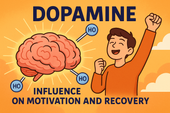
Dopamine’s Influence on Motivation and Recovery: Reigniting Drive and Balance
Healthy relationships are the foundation of emotional balance and resilience. Whether romantic, familial, or platonic, genuine connection releases dopamine, serotonin, and oxytocin — the brain’s “bonding trio” — helping us feel secure, motivated, and seen. Learn how trust, empathy, and communication not only strengthen your connections but also reshape your nervous system for deeper emotional well-being. 🌿🤝
-
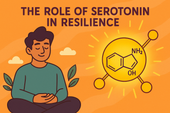
The Role of Serotonin in Resilience: How This “Mood Molecule” Shapes Emotional Strength
Serotonin — often called the “resilience molecule” — plays a vital role in how we handle stress, regulate mood, and recover from emotional challenges. Beyond happiness, this powerful neurotransmitter helps balance the gut-brain axis, stabilize the nervous system, and support emotional flexibility. Learn how nutrition, sunlight, mindfulness, and adaptogens can naturally boost serotonin and strengthen your emotional resilience. 🌞🧠
-
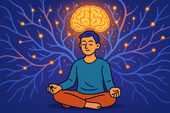
How Neuroplasticity Supports Emotional Growth: Rewiring the Brain for Resilience
Neuroplasticity is the brain’s built-in power to grow, adapt, and heal — and it’s the foundation of emotional transformation. Every mindful breath, compassionate act, or reframed thought strengthens new neural pathways that support resilience and self-awareness. Learn how your brain rewires through daily habits, helping you turn emotional challenges into opportunities for growth and calm. 🌿
-
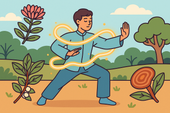
Tai Chi and Adaptogens for Mind-Body Balance: The Art of Harmonizing Energy and Resilience
Alchemy isn’t just an ancient science — it’s a timeless symbol of transformation and inner balance. By blending the physical and spiritual, alchemy teaches us that change begins from within. Just as metals are refined into gold, we too can transmute emotional pain, stress, and chaos into clarity and strength through mindful practice and self-awareness. 🌙✨
-
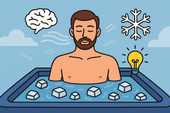
Cold Therapy and Emotional Control: Training the Mind Through the Body
Cold therapy isn’t just for athletes — it’s a tool for emotional mastery. By exposing your body to controlled cold, you train your nervous system to stay calm under stress, improving focus, mood, and resilience. This article explores the science of cold exposure, its impact on hormones and the vagus nerve, and how ice baths and cold showers can help you build emotional control, one breath at a time. 🧊🧘♂️
-

How Music Influences Emotional Recovery: The Healing Soundtrack of the Mind
Neuroplasticity — the brain’s ability to rewire and heal itself — is at the heart of emotional recovery. Through mindful habits, music, therapy, and consistent mental stimulation, your brain can form new connections that support resilience and well-being. Discover how neuroplasticity turns pain into growth, helping you rebuild balance, focus, and emotional strength. 🌿
-
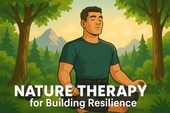
Nature Therapy for Building Resilience: Reconnecting With the Healing Power of the Earth
Nature therapy helps rebuild emotional resilience by reconnecting you with the healing rhythms of the Earth. From forest walks to sunlight exposure, nature restores balance to your nervous system, lowers stress hormones, and teaches emotional adaptability. Learn how spending time outdoors can enhance mental clarity, calm anxiety, and awaken your natural capacity to heal. 🌞
-
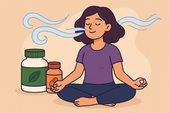
Breathwork Techniques That Pair with Supplements: The Ultimate Synergy for Stress Relief and Mental Clarity
Breathwork and supplements create a powerful mind-body synergy for stress relief, focus, and energy. By combining intentional breathing with adaptogens, nootropics, and calming nutrients, you can naturally regulate cortisol, sharpen mental clarity, and boost emotional balance. This guide explores the best breathwork techniques and supplement pairings to help you feel centered, calm, and energized from the inside out. 🌿
-
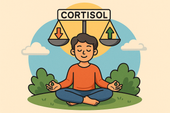
Why Cortisol Balance Matters for Emotional Strength
Balancing cortisol — your body’s main stress hormone — is essential for emotional resilience. When cortisol is chronically high, your mind stays stuck in survival mode, leading to fatigue, anxiety, and emotional instability. This article explores how nutrition, supplements, breathwork, and therapy can help restore healthy cortisol rhythms, regulate the nervous system, and strengthen your ability to handle life’s challenges with calm focus and emotional strength. 🌿

















































